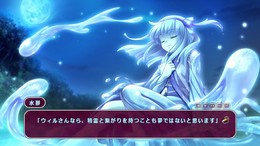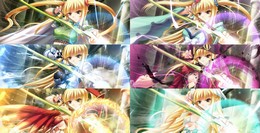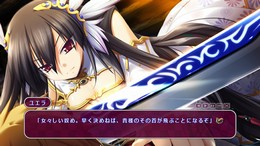Alchemy Meister – The God Captor Impressions
May 10th, 2011
I meant to post this a week and a half ago. Oh well.
In the alchemist city of Yuidora, Wilfred manages to pass his final exam and open a workshop of his own. Soon after, a mysterious foreign swordswoman from a foreign land appears at his door and demands that he reforge and restore the magic in her sword. With the means unknown to any in the city and the cost prohibitive, he strikes a deal with the girl, Yuela, that she’ll be his escort when he goes out to collect materials and he’ll find a way to reforge her sword. Wil soon also befriends Emiritta, an energetic mage, and Selawi, a hippie elf, as well as any number of elemental spirits that all join his workshop, and also encounters a mysterious reaper that has both a connection to his parents’ death as well as Yuela.
If the above setup reminded you of one of Gust’s Atelier games, then you’re not far off, particularly Atelier Iris 3, right down to playing Pretty Princess Dressup. Kamidori is Eushully’s latest game and the spiritual successor to Himegari, but contains a much stronger focus on item creation and a much weaker focus on the protagonist raping everything with four or fewer legs, which was not exactly an appealing part of Himegari for me. On the other hand, if not for all the elementals pinning Wil down to… uh… deepen the bond between spirits and humans… I would be questioning his interest in females at all. He does seem to have an apparently insatiable urge to knit frilly dresses.
At its core, Kamidori is an SRPG, and a rather complex one at that. A lot of it is carryover from Himegari, but I may as well cover it, and the maps are generally much more compact, resulting in a more focused game. Aside from your usual standards like elemental weaknesses, skills, and magic vs ranged vs physical, there’s fatigue points limiting movement, terrains, enemy portals, hidden rooms, multiple spawn points, zones of control, etc etc. As you proceed, you’ll also accumulate elemental-based costumes (goth also being an element) for the heroines and a bucketload of skills to mix and match in order to customize your party for whatever you want. Wil and the heroines also come with grids ala FFX or Mana Khemia to upgrade their stats and learn new skills. Each costume has its own grid too, so the number of ways you can even develop your core party is huge and there is no way you’ll cover it in a single playthrough.
As you can see below, it’s very similar in general structure to Fire Emblem, right down to very random leveling that can sometimes drive you insane when your mages get nothing but physical attack multiple times in a row. One thing I really approve of is the focus on breadth growth for characters instead of depth. IE, as you advance, the focus is on providing more options, not just upgrading Fire to Fire2 to Fire3 to Flare and calling it a day. There’s hardly a need to take full advantage of it most of the time, but some skills do drastically change how you’ll use characters when they’re equipped. You can also replay maps as much as you want with enemies leveling in parallel, which is just enough to keep the random material farming adventures engaging. Deployment points and zones stay under your control after you leave a map too, so it’s also thankfully quick work, much moreso once you have the Search skill to find the hidden resource points on multiple characters.
I do readily admit that I really don’t like Eushully’s lack of animation in their battles and it annoys me a lot in their other RPGs. We’ve moved beyond the Wizardry era, guys. Let’s step up the animation along with the art, eh? It’s a little more stomachable in SRPG form than RPG where you’re staring at the same static screen for up to 10 minutes on major fights as numbers boringly scroll past… and would probably switch it to quick-display soon enough anyway, but they’ve clearly got some talented artists and they could definitely be doing a little more than drawing 20 slightly different harpies. I find the ‘battle damage’ inflicted on the female monsters hilariously gratuitous as well.



On the other hand, there’s definitely overkill in the detail at times, such as the massive unsearchable terminology dictionary or having about ten different textual descriptors for levels of elemental weaknesses/strength. Would numbers really have been a worse idea than Weak vs Slightly Weak vs Vulnerable vs Defenseless vs etc. I shouldn’t have to consult a chart to remember whether one means +10% to damage or +90%. Zones of control are also a good example. You claim territory by moving onto it or by having a unit in a room with no enemies. If you don’t control a zone, you can only move one square at a time. Most rooms are small, so it’s a simple matter to just clear the enemies out and seize the whole thing or just leap-frog characters, but there are also large rooms where an enemy will sit in the corner on the far side as you slowly… SLOWLY trundle all the way across the map, one square at a time. Meanwhile, the enemy AI will just be walking back and forth in the corner until it ducks out of the room when you get close, instantly giving you complete control of it. Fatigue, which limits movement, is also something that you will ignore 99% of the time but becomes nothing but a time wasting annoyance when it runs out.
There’s a little more to the game than just the battle engine, but the merchandising and alchemy side is fairly under-realized compared to what Gust’s refined over of the last couple decades. You’ve got your workshop, you can decorate it with various things that improve its stats, party members can work in it, and you can sell the things you make. The problem is that it’s just something that happens in the background automatically. Stick stuff up for sale and then either hit the "day skip" button or go to a dungeon, earn money. Or not if you chose a poor shopkeeper. The lack of any kind of real interaction makes it very superfluous at best.
The characters and writing can also be fairly weak. Aside from Wil, whose answer to everything from what his plans are for breakfast to what he’s going to do about the angel contemplating destroying the city is "I want to make people smile," the characters are mostly decent enough. However, it can sometimes feel manic when it jumps from scenes of people fleeing from your store because your earth elemental is accidentally crushing people, to people flocking to the store because there’s an angel hanging out there. All the while, there’s a giant wolf on the lawn, an ancient fox demanding increasingly expensive liquor, twin elves hitting people with nuts, and a succubus licking Wil’s face in his sleep… all of which are completely optional sidequests. Wil’s arbitrary desire to raise his workshop up a level as the ‘driving plot’ for much of the game is not exactly compelling in comparison. The heroine routes that I’ve played so far (had some bug issues that required starting over and switched from Yuela to Selawi) don’t fare too much better. I can’t speak for Emiritta’s or the later parts of Yuela’s routes, but much of Selawi’s is spent hugging trees and cleaning up pollution. Get a job, hippie! *ahem* The point is that plot and direction are not where the game shines.
Overall though, while the central plot is weak, it’s still fun and boasts an extremely engaging engine. It’s very recommendable, doubly so if you’ve enjoyed almost any Gust game since it basically is Atelier Iris 3, the SRPG porn edition. The minor quibbles are easily overlooked given just how much there is to do in the game and particularly the way it keeps moving along without any forced grinding or save scumming… not that any other recent game comes to mind. It’s definitely worth a shot if you have a chance.
Posted in Kamidori | 13 Comments »













So there isn’t a time limit like in Pre-Iris, huh.